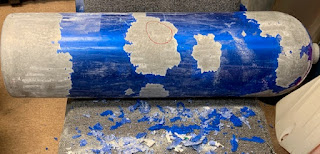Give Your Cylinders a New Look
 |
| Poor post-dive rinsing took its toll on this ocean diver's 80 but it's just cosmetic. |
Fred Stratton
Instructor and Technician
fred@bubblesornot.com
Painting Scuba Cylinders
 Some divers give little thought to their cylinders. They only care that they don't leak and pass annual inspections and hydrostatic retesting once every five years. Other divers are meticulous about every piece of gear, including their cylinders. They put boots, dust caps and nets on them to keep that showroom paint job intact.
Some divers give little thought to their cylinders. They only care that they don't leak and pass annual inspections and hydrostatic retesting once every five years. Other divers are meticulous about every piece of gear, including their cylinders. They put boots, dust caps and nets on them to keep that showroom paint job intact.
If you regularly dive it's inevitable that your bottles will get chipped and scratched and as water works its magic, the paint will flake off. So what can you do when it happens?
"Can I strip the paint off my cylinders without damaging the metal?"
 |
| The stripper works quickly. Scrape the peeled paint before it dries. |
American cylinder manufacturers Catalina and Luxfer recommend using Zip Strip to rid your cylinder of what remains of the factory finish. These photos illustrate the process in action. It took about 12 ounces of Zip Strip for each of these uncommon 90cf aluminum cylinders. Following the instructions by applying the stripper in one direction worked well. I tried applying with the cylinders standing up and lying down. Vertical seemed to work best; dripping stripper just keep stripping as it runs down the side.
Directions are simple; wear a mask, use in a well ventilated space and properly dispose of rags and brushes. (One-dollar brushes suffice.)
After the paint stops peeling scrape it off with a putty knife. Wipe with rags or paper towels to see what paint remains and then apply more stripper. I had to repeat this process five or six times but the results were terrific. I prefer the aluminum finish because it looks clean and it doesn't mask corrosion underneath a failing finish.
After you are done stripping use Simple Green to wash away any Zip Strip residue.
 |
| The end result. These 20-year old cylinders look new again. |



Comments
Post a Comment